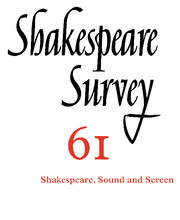Book contents
- Frontmatter
- Sarah Siddons, theatre voices and recorded memory
- Playing with Shakespeare’s play: Branagh’s Love’s Labour’s Lost
- Bottom and the gramophone: Media, class and comedy in Michael Hoffman’s A Midsummer Night's Dream
- Maurice Evans’s Richard II on Stage, Television and (Almost) Film
- Richard II on the Screen
- ‘Where Lies Your Text?’: Twelfth Night in American Sign Language Translation
- ‘This uncivil and unjust extent against thy peace’: Tim supple’s Twelfth Night, or what violence will
- ‘There’s no such thing’: nothing and nakedness in Polanski’s Macbeth
- Ghosts and mirrors: the gaze in film Hamlets
- ‘Ben, it’s a terrible thing to hate your mother’: mind control in Hamlet and The Manchurian Candidate
- Channelling the ghosts: the Wooster Group’s remediation of the 1964 Electronovision Hamlet
- Listening to Prospero’s Books
- Lend Me Your Ears: Sampling BBC Radio Shakespeare
- An Age of Kings and The ‘Normal American’
- Shakespeare and British Television
- A Local Habitation and a Name: Television and Shakespeare
- Paying attention in Shakespeare parody: from Tom Stoppard to YouTube
- Madagascan will: cinematic Shakespeares / transnational exchanges
- Still life? Anthropocentrism and the fly in Titus Andronicus and Volpone
- Riddling q1: Hamlet’s mill and the trickster
- ‘Speak, that I may see thee’: Shakespeare characters and common words
- Who do the people love?
- A Partial Theory of Original Practice
- Shakespeare Performances in England, 2007
- Professional Shakespeare productions in the British Isles, January–December 2006
- The Year's Contributions to Shakespearian Study 1 Critical studies
- 2 Shakespeare in performance
- 3a Editions and textual studies
- 3b Editions and textual studies: The RSC Complete Works
- Index to Volume 61
The Year's Contributions to Shakespearian Study 1 - Critical studies
Published online by Cambridge University Press: 28 November 2008
- Frontmatter
- Sarah Siddons, theatre voices and recorded memory
- Playing with Shakespeare’s play: Branagh’s Love’s Labour’s Lost
- Bottom and the gramophone: Media, class and comedy in Michael Hoffman’s A Midsummer Night's Dream
- Maurice Evans’s Richard II on Stage, Television and (Almost) Film
- Richard II on the Screen
- ‘Where Lies Your Text?’: Twelfth Night in American Sign Language Translation
- ‘This uncivil and unjust extent against thy peace’: Tim supple’s Twelfth Night, or what violence will
- ‘There’s no such thing’: nothing and nakedness in Polanski’s Macbeth
- Ghosts and mirrors: the gaze in film Hamlets
- ‘Ben, it’s a terrible thing to hate your mother’: mind control in Hamlet and The Manchurian Candidate
- Channelling the ghosts: the Wooster Group’s remediation of the 1964 Electronovision Hamlet
- Listening to Prospero’s Books
- Lend Me Your Ears: Sampling BBC Radio Shakespeare
- An Age of Kings and The ‘Normal American’
- Shakespeare and British Television
- A Local Habitation and a Name: Television and Shakespeare
- Paying attention in Shakespeare parody: from Tom Stoppard to YouTube
- Madagascan will: cinematic Shakespeares / transnational exchanges
- Still life? Anthropocentrism and the fly in Titus Andronicus and Volpone
- Riddling q1: Hamlet’s mill and the trickster
- ‘Speak, that I may see thee’: Shakespeare characters and common words
- Who do the people love?
- A Partial Theory of Original Practice
- Shakespeare Performances in England, 2007
- Professional Shakespeare productions in the British Isles, January–December 2006
- The Year's Contributions to Shakespearian Study 1 Critical studies
- 2 Shakespeare in performance
- 3a Editions and textual studies
- 3b Editions and textual studies: The RSC Complete Works
- Index to Volume 61
Summary
BEFORE SHAKESPEARE
Janette Dillon’s Cambridge Introduction to Early English Theatre is a nicely judged, sensibly structured, lucidly written introduction to medieval and early Renaissance drama, complete with a variety of illustrations and quotations from all kinds of relevant documents helpfully set off in shaded boxes. Every now and then Dillon judiciously breaks away from her main narrative to focus for a couple of pages on an exemplary piece of representative dramatic entertainment: Mankind (1465–70), The Death of Herod (1450–75), Tamburlaine Parts One and Two (1587–8), The Masque of Blackness (1605). These case studies are supplemented by shorter considerations of other plays: for example, The Lady of May (1578–9), King Lear (1605–6) and A Game at Chess (1624). The chronological arc of the book is only just noticeable as Dillon prefers to deal with her subject-matter under a number of mutually illuminating thematic links: genre and tradition, instruction and spectacle, actors and audiences, and the like. Overall it’s a lively, entertaining and stimulating mix, modelled, one might say, on the very material under consideration.
For we learn that this material is not easily pegged or sharply demarcated. It’s slippery stuff. There is an essential blurring of boundaries, categories, binaries and chronologies. The indispensable term here is the sixteenth-century mot juste, ‘mingle-mangle’. The history of early English theatre, Dillon claims, is far more mingled (and much less mangled) than we have up to now been led to believe. For one thing, the dramatic past continued into the dramatic present in all manner of ways. Continuities abounded. Indoor theatres, for instance, were mainly conversions of halls originally designed for other purposes. (It’s instructive to learn, by the way, that in 1525 there were more active playhouses than at any time in Elizabeth’s reign.)
- Type
- Chapter
- Information
- Shakespeare Survey , pp. 359 - 383Publisher: Cambridge University PressPrint publication year: 2008

